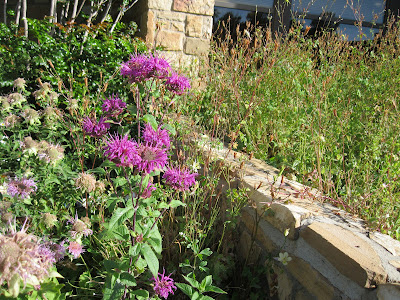Summer visitors to the
Anasazi Heritage Center near Dolores, Colorado will notice the colorful display of flower beds near the entrance. There is a co-operative program called
Plant Select that has developed this Demonstration Garden using native Four Corners plants and selected others. The Anasazi Heritage Center is the Visitor Center for the Canyons of the Ancients National Monument.
These plants are well adapted to this zone that is between the Pinon and Juniper forest and the Ponderosa and Gambel Oak forest. There is a free guide to all these plants inside the Heritage Center. I visited on June 9, just as some of the plants were coming into spectacular bloom. The
Chuska Puma, one of the Pumas on Parade, has a good position on the left side of the entrance plaza.
Shrubby Cinquefoil in the Rose Family has colorful yellow blossoms and is found along trails in the Four Corners. Behind are red and yellow
Blanket Flowers. The guide mentions the uses that early residents had for many of these plants.
The combination of the blue and white
Rocky Mountain Columbine with the
Denver Gold Columbine is spectacular in early June. There is also a Red Columbine that occurs along trails and is here at the garden, though I don’t think I saw it on this visit. Columbines are in the Buttercup Family.
Some of the plants, like these
Wine Cups, have Plant Select labels. For some it is harder to find the labels and the plant guide is helpful for those. The plant guide has common names and genus names but doesn't seem to include plant families.
The
Desert Four O’clock or Miribilis is one of my favorites to find along the trails.
Apache Plume in the Rose Family has feathery plumes that carry the seeds. It probably had many white flowers that have already faded. Behind it I think is the ornamental Green Ash. I could see the small canoe paddle shaped seeds getting ready to flutter down.
There are many more to find and the plants in bloom will change through the growing season.
Toward the end of June the Coneflowers come into bloom.
Purple Coneflowers and ...
Prairie Coneflowers.
In addition to the plant beds near the entrance, the whole site, even the parking area can be considered as a botany resource.
At the end of July, Bee Balms are replacing the columbines in front of the Chuska Puma. The one mile round trip interpretive trail to the Escalante Pueblo site also has identification for some the native plants.











